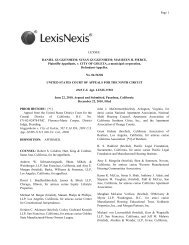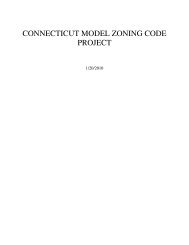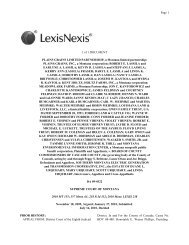Through a Glass Darkly: Measuring Loss Under ... - Land Use Law
Through a Glass Darkly: Measuring Loss Under ... - Land Use Law
Through a Glass Darkly: Measuring Loss Under ... - Land Use Law
You also want an ePaper? Increase the reach of your titles
YUMPU automatically turns print PDFs into web optimized ePapers that Google loves.
MEASURING LOSS UNDER MEASURE 37 603<br />
or enforced. We have thus far considered the competing methods to<br />
determine which model is most accurate in establishing the counterfactual<br />
and, thus, best at assessing the devaluation caused by the enactment<br />
or enforcement of the land use regulation. Let us now review the competing<br />
methods to determine that which best fits the legal framework<br />
established by Measure 37.<br />
A. Conceptual Category One: The Exemption Method<br />
Those who defend the exemption method as the basis for evaluating<br />
Measure 37 claims have, in essence, resorted to two central arguments:<br />
first, that the proposed alternative valuation methods are “even more<br />
flawed [than the exemption method]” 132 and second, that the “clear” 133<br />
language of subsection (2) dictates the use of the exemption method<br />
regardless of its economic inaccuracies.<br />
Both of these propositions are themselves inaccurate. As we have seen,<br />
while the alternative valuation methods have their own flaws, none are as<br />
inaccurate as the exemption method 134 : a method, lest we forget, which is<br />
wholly unable to establish whether a particular land use regulation has<br />
had a negative effect, no effect, or indeed a positive effect on the affected<br />
land’s value. Nor is the language of subsection (2) clear: the prima facie<br />
plausibility of Sercombe’s interpretation demonstrates that the language<br />
is inherently ambiguous. Furthermore, controversial interpretative<br />
questions—such as whether the causative event in question is the enactment<br />
or enforcement of the land use regulation or, alternatively, whether both<br />
should be taken into account—abound. 135 However, the one proposition<br />
about which we can be relatively clear is that the exemption method has<br />
132. See Letter from David Hunnicutt, Executive Director, Oregonians in Action, to<br />
the Joint <strong>Land</strong> <strong>Use</strong> Fairness Comm. (Mar. 2, 2007) (on file with author).<br />
133. Id.<br />
134. See Jaeger, supra note 101.<br />
135. The assumption that the exemption method is valid is evident in the only case<br />
that has addressed the question of valuation. In Vanderzanden v. <strong>Land</strong> Conservation &<br />
Development Commission, Case No. 05C19565 (Marion County, Or. Cir. Ct. Jan. 8,<br />
2007) (letter opinion) Circuit Judge Don Dickey stated that: “By virtue of the plain language<br />
of [subsection] 197.352(1) [of the Oregon Revised Statutes], public entities are<br />
required to consider whether the value of the property without the applicable regulation<br />
would be different from the value of the property with the regulation.” That may well be<br />
the “plain language” of the section; however, the judge assumed that the only method to<br />
determine this difference was to consider the magnitude of the increase in value should<br />
the applicable regulation be waived: “Necessarily, then, the public entity must consider<br />
what value the property might have if the requisite waiver were granted.” Id.<br />
With due respect to the judge it is submitted that his conclusion as to the correct<br />
valuation method is far from necessitated by his premise. Indeed, this article goes to<br />
great lengths to explicate the various valuation methodologies which may plausibly lay<br />
claim to capture the differential the judge identifies as his premise.<br />
ABA-TUL-07-0701-Sullivan.indd 603<br />
9/18/07 10:43:44 AM







